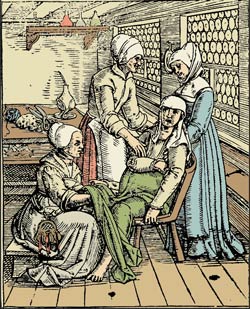Denise Lemaître, Sage-Femme.
Recruited to Build a Nation.
Mademoiselle Jeanne Mance, a founder of Ville-Marie (later Montréal), returned to Paris in 1653 to sign up young women to teach, work in the hospital l'Hôtel-Dieu de Montréal, and to marry the men in the settlements with an eye toward populating the colony. She located our 23-year-old ancestor Denise Lemaítre, the daughter of Denis Lemaître and the late Catherine Deharme, living on rue Saint-Antoine in Paris.
Mance's recruits departed La Rochelle on 2 July 1659 aboard the Saint-André. A dozen travelers died of typhus during the journey across the Atlantic. Landing in the port at Québec 7 September 1659 the passengers were held for several weeks before being allowed to proceed to Montréal (in part to recover, in part because Bishop François de Laval wished to keep the nurses for the hospital in Québec).
As one among les Filles à marier Denise signed a contract in Montréal on 5 October 1659 to marry André Heurtebise but the 29-year-old groom died in the hospital before the marriage took place. He was buried on 2 December of that year.
Sage-femme, or Midwife.
Pregnancy and childbirth were a leading cause of death in the 17th century, indeed many of our ancestors succumbed. For the most part, doctors did not participate in the birthing process (a mixed blessing, since doctors' lack of hygiene caused many a fatality in later centuries as they spread puerperal fever).

and warm to mimic the womb
Denise Lemaître was a sage-femme. France passed laws as early as the 15th century to protect midwives from being accused of witchery and training for them began by the 17th century. A knowledge of herbal remedies often expanded the range of ailments they treated.
There were no reliable tests to determine if a woman was pregnant, and little in the way of birth control. The word "quick" meant "life" thus the quickening or first movements felt by the woman marked the beginning of life at around 17 weeks of her pregnancy. Prior to that herbs such as pennyroyal or soapwort were used to facilitate the resumption of the menstrual cycle if called upon.
Once in labor, women were set in a birthing stool with a u-shaped seat. Someone positioned behind helped steady her through labor. Stones, amber or amulets were sometimes rubbed on her body to speed the process. If it was necessary to reposition the baby the midwife may have used wild thyme oil on her hands.
A crochet or hook was employed for difficult deliveries, often a last ditch attempt to extract the child to save the mother. (Forceps were a closely guarded secret held by a family of man-midwives in England, one that died with them and was not rediscovered until a century later.) Caesarian operations were likewise used primarily to save the mother.
There was plenty of work to do. With the arrival of the first of les Filles du roi around 1663 many women gave birth in same time period creating a baby boom. They tended to produce about 30% more children than their counterparts in France. The King provided incentives for large families in the colony, thus a family of eleven children was not unheard of.
- Godbout, P. Archange, O.F.M., Les Passagers du Saint-André, La Recrue de 1659, (Société Généalogique Canadienne-Français, No. 5, Montréal 1964), p.36.
- Jetté, René, Dictionnaire généalogique des familles du Quebec des origines à 1730 (Montréal: Les Presses de l'Université de Montréal, 1983)
- https://www.jeanne-mance.fr/uploads/JEANNE%20MANCE%20biographie%20JPP.pdf
- https://www.britannica.com/science/midwifery
- https://dorindabalchin.com/2017/03/07/call-the-midwife-pregnacy-and-childbirth-in-the-17th-century/
- https://www.dailymail.co.uk/news/article-2174297/Might-want-Call-Midwife-Grisly-17th-century-book-shows-medics-used-treat-labour.html
- https://opentextbc.ca/postconfederation/chapter/1-2-historical-demography-of-canada-1608-1921/
